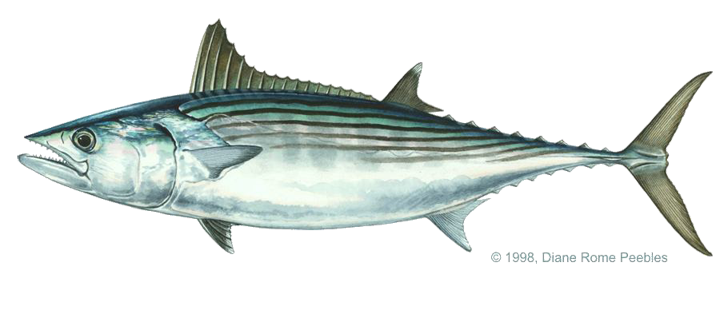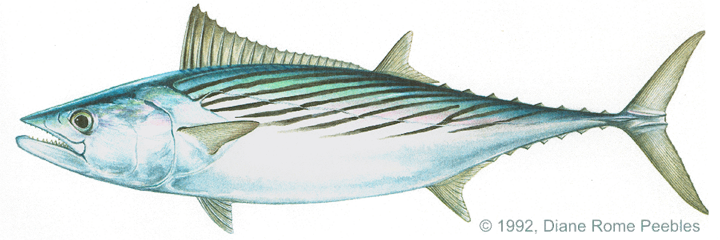Game Fish Identification Reference Guides
Bonito, Pacific
(Sarda spp.)
(Sarda spp.)

(Temminck & Schlegel, 1844); striped bonito / Sarda chiliensis (Cuvier, 1831); California bonito, eastern Pacific bonito / Sarda australis (Macleay, 1880); Australian bonito; SCOMBRIDAE FAMILY;
Sarda chiliensis is restricted to the eastern Pacific Ocean. Its range is divided into two separate populations. The northern population (Sarda chiliensis lineolata) ranges from Alaska to southern Baja and the Revillagigedo Islands off Mexico. The southern population (Sarda chiliensis chiliensis) ranges from Peru to Chile. The two populations are replaced from Baja, California to Peru by Sarda orientalis (the most widespread of the species of Sarda listed above) which also occur in scattered populations throughout the Pacific and Indian Oceans. Sarda australis has the most restricted range of the three occurring only off the eastern coast of Australia. Distinguishing the Pacific bonitos from each other and from other Pacific Scombroid species has been confusing for many anglers. Superficially, many of the species resemble each other closely. The Sarda species differ from all other bonitos (with the exception of Allothunnus fallai, the so called slender tuna) in having no teeth on the tongue and in having a straight intestine with no fold in the middle. The Sarda species are not normally confused with Allothunnus and can be easily distinguished by the number of gill rakers: Sarda has 8 27 on the first arch (S. orientalis, 8 13; S. australis, 19 21; S. chiliensis, 23 27) whereas Allothunnus had 72 80. The Sarda species are further characterized by the first dorsal fin which has 17 19 spines. Like all bonitos (with the exception of Gymnosarda, the dogtooth tuna) Sarda has no swim bladder. Sarda australis has stripes on the belly as well as on the back, but other Sarda species lack any sort of stripes, lines, or spots on the belly.
Bonitos are migratory, schooling, pelagic fishes. They feed on smaller pelagic fishes and on squid, usually near the surface. Fishing methods include surface trolling; also casting, jigging, live baiting or ues of a variety of small artificial lures. The flesh is light colored and of good quality
Sarda chiliensis is restricted to the eastern Pacific Ocean. Its range is divided into two separate populations. The northern population (Sarda chiliensis lineolata) ranges from Alaska to southern Baja and the Revillagigedo Islands off Mexico. The southern population (Sarda chiliensis chiliensis) ranges from Peru to Chile. The two populations are replaced from Baja, California to Peru by Sarda orientalis (the most widespread of the species of Sarda listed above) which also occur in scattered populations throughout the Pacific and Indian Oceans. Sarda australis has the most restricted range of the three occurring only off the eastern coast of Australia. Distinguishing the Pacific bonitos from each other and from other Pacific Scombroid species has been confusing for many anglers. Superficially, many of the species resemble each other closely. The Sarda species differ from all other bonitos (with the exception of Allothunnus fallai, the so called slender tuna) in having no teeth on the tongue and in having a straight intestine with no fold in the middle. The Sarda species are not normally confused with Allothunnus and can be easily distinguished by the number of gill rakers: Sarda has 8 27 on the first arch (S. orientalis, 8 13; S. australis, 19 21; S. chiliensis, 23 27) whereas Allothunnus had 72 80. The Sarda species are further characterized by the first dorsal fin which has 17 19 spines. Like all bonitos (with the exception of Gymnosarda, the dogtooth tuna) Sarda has no swim bladder. Sarda australis has stripes on the belly as well as on the back, but other Sarda species lack any sort of stripes, lines, or spots on the belly.
Bonitos are migratory, schooling, pelagic fishes. They feed on smaller pelagic fishes and on squid, usually near the surface. Fishing methods include surface trolling; also casting, jigging, live baiting or ues of a variety of small artificial lures. The flesh is light colored and of good quality













